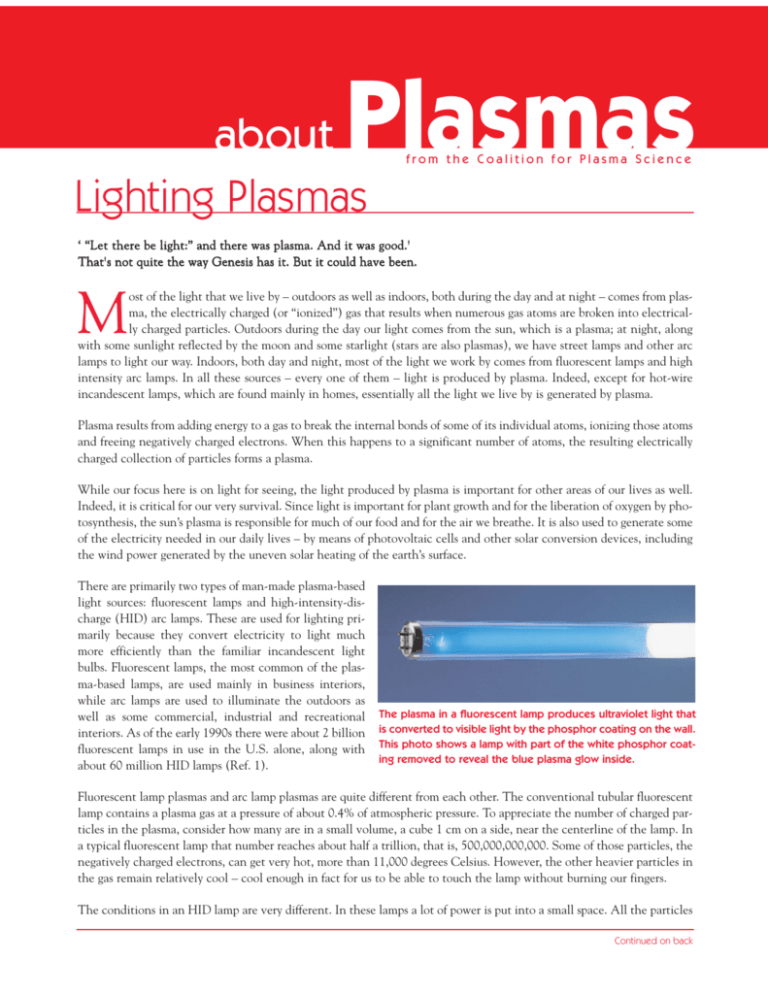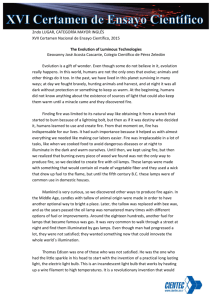Lighting Plasmas - Coalition for Plasma Science
advertisement

Plasmas about Lighting Plasmas from the Coalition for Plasma Science ‘ “ L e t t h e r e be light:” and ther e was plasma. And it was good.' That's not quite the way Genesis has it. But it could have been. M ost of the light that we live by – outdoors as well as indoors, both during the day and at night – comes from plasma, the electrically charged (or “ionized”) gas that results when numerous gas atoms are broken into electrically charged particles. Outdoors during the day our light comes from the sun, which is a plasma; at night, along with some sunlight reflected by the moon and some starlight (stars are also plasmas), we have street lamps and other arc lamps to light our way. Indoors, both day and night, most of the light we work by comes from fluorescent lamps and high intensity arc lamps. In all these sources – every one of them – light is produced by plasma. Indeed, except for hot-wire incandescent lamps, which are found mainly in homes, essentially all the light we live by is generated by plasma. Plasma results from adding energy to a gas to break the internal bonds of some of its individual atoms, ionizing those atoms and freeing negatively charged electrons. When this happens to a significant number of atoms, the resulting electrically charged collection of particles forms a plasma. While our focus here is on light for seeing, the light produced by plasma is important for other areas of our lives as well. Indeed, it is critical for our very survival. Since light is important for plant growth and for the liberation of oxygen by photosynthesis, the sun’s plasma is responsible for much of our food and for the air we breathe. It is also used to generate some of the electricity needed in our daily lives – by means of photovoltaic cells and other solar conversion devices, including the wind power generated by the uneven solar heating of the earth’s surface. There are primarily two types of man-made plasma-based light sources: fluorescent lamps and high-intensity-discharge (HID) arc lamps. These are used for lighting primarily because they convert electricity to light much more efficiently than the familiar incandescent light bulbs. Fluorescent lamps, the most common of the plasma-based lamps, are used mainly in business interiors, while arc lamps are used to illuminate the outdoors as well as some commercial, industrial and recreational interiors. As of the early 1990s there were about 2 billion fluorescent lamps in use in the U.S. alone, along with about 60 million HID lamps (Ref. 1). The plasma in a fluorescent lamp produces ultraviolet light that is converted to visible light by the phosphor coating on the wall. This photo shows a lamp with part of the white phosphor coating removed to reveal the blue plasma glow inside. Fluorescent lamp plasmas and arc lamp plasmas are quite different from each other. The conventional tubular fluorescent lamp contains a plasma gas at a pressure of about 0.4% of atmospheric pressure. To appreciate the number of charged particles in the plasma, consider how many are in a small volume, a cube 1 cm on a side, near the centerline of the lamp. In a typical fluorescent lamp that number reaches about half a trillion, that is, 500,000,000,000. Some of those particles, the negatively charged electrons, can get very hot, more than 11,000 degrees Celsius. However, the other heavier particles in the gas remain relatively cool – cool enough in fact for us to be able to touch the lamp without burning our fingers. The conditions in an HID lamp are very different. In these lamps a lot of power is put into a small space. All the particles Continued on back in the plasma get very hot (typically several thousand degrees Celsius); the pressure can reach several times atmospheric pressure; and the charged particle density (i.e., the number in a cubic centimeter) can reach about 1,000,000,000,000,000 – that is one thousand trillion. This is higher than charged particle densities in parts of the sun and in most thermonuclear fusion devices being explored for generating electricity. In a fluorescent lamp the plasma actually produces nonvisible ultraviolet light, which is converted to visible light by the phosphor coating on the tube’s inside wall. (It is this coating material that makes the lamp appear white when not operating.) An HID arc plasma, on the other hand, produces visible light directly. In a fluorescent lamp the ultraviolet light is produced by a small amount of mercury in the gas; in other low-pressure tubular lamps (e.g., neon lamps and low-pressure sodium lamps) and in HID lamps (e.g., high-pressure mercury lamps, high-pressure sodium lamps, and metal halide lamps) the visible light is produced directly by various gases and vapors, in some cases, especially metal halide lamps, by complex mixtures. In a high-intensity arc lamp the light is generally produced directly by the plasma. These are the lamps that create the spectacular panoramic views of cities as you fly over them at night. Light production is important for our economy. As of the early 1990s light production in the U.S. accounted directly for about 20% of electrical energy use. That number increases to about 33% if we include the additional electricity required for air cooling to remove heat generated by lamps. With electricity accounting for about 40% of the energy used in the U.S., lighting is indeed a significant factor in the nation's overall energy consumption. Clearly it is important to develop lamps that are more energy-efficient, and the lighting industry is working on this. Moreover, the future also promises to bring new and improved types of plasma-based lamps, including better compact fluorescent lamps, more electrodeless lamps (powered indirectly rather than with wires connected to internal electrodes), and lamps with less or no mercury. This NASA photograph reveals evening lighting in the U.S. and its neighbors, much of it from arc plasma lamps. The light from those lamps may signal our presence to alien civilizations. A lamp researcher has observed (Ref. 2) that "in terms of total quantities of plasma being continuously generated, lighting plasmas are far and away the predominant practical application of plasma science." However, because the use of plasma lamps is so widespread and familiar, we generally fail to notice their significance to our lives and our economy. There is yet another area where their significance may be undervalued. It has been pointed out (Ref. 3) that the light generated by plasma sources is the only work of man that can be seen from outer space. Given its color characteristics, that light would be clearly recognizable to an alien civilization as a sign of intelligent life on Earth. Indeed, maybe this has already happened. References and Suggested Reading: 1. G.L. Rogoff, "Energy Conservation and Environmental Aspects of Lighting Plasmas" in Plasma Science and the Environment, edited by W. Manheimer, L.E. Sugiyama, and T. H. Stix (American Institute of Physics, New York, 1997), Chap. 8. 2. J.F. Waymouth, "LTE and Near-LTE Lighting Plasmas," Invited Review Paper in Special Issue on Applications of Partially Ionized Plasmas, G.L. Rogoff, Guest Editor, IEEE Transactions on Plasma Science, Vol. 19, p. 1003-1012 (December, 1991). 3. J.F. Waymouth, "Overview" in Radiative Processes in Discharge Plasmas, edited by J. M. Proud and L. H. Luessen (Plenum, New York, 1986) pp. 1-6. Text: G.L. Rogoff. Editor: Paul Rivenberg Images: Paul Kevin Picone/OSRAM SYLVANIA; Craig Mayhew and Robert Simmon, NASA GSFC, based on Defense Meteorological Satellite Program data. For more information: Call Toll Free 1-877-PLASMAS (752-7627) • e-mail: CPS@plasmacoalition.org Visit our website at http://www.plasmacoalition.org 0406 © 2002, 2006 Coalition for Plasma Science





